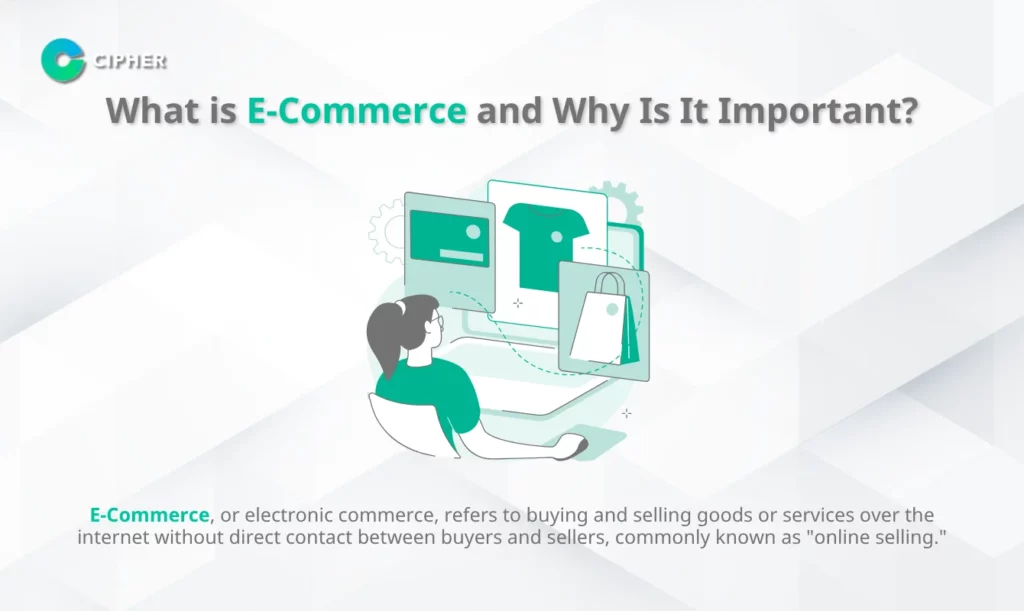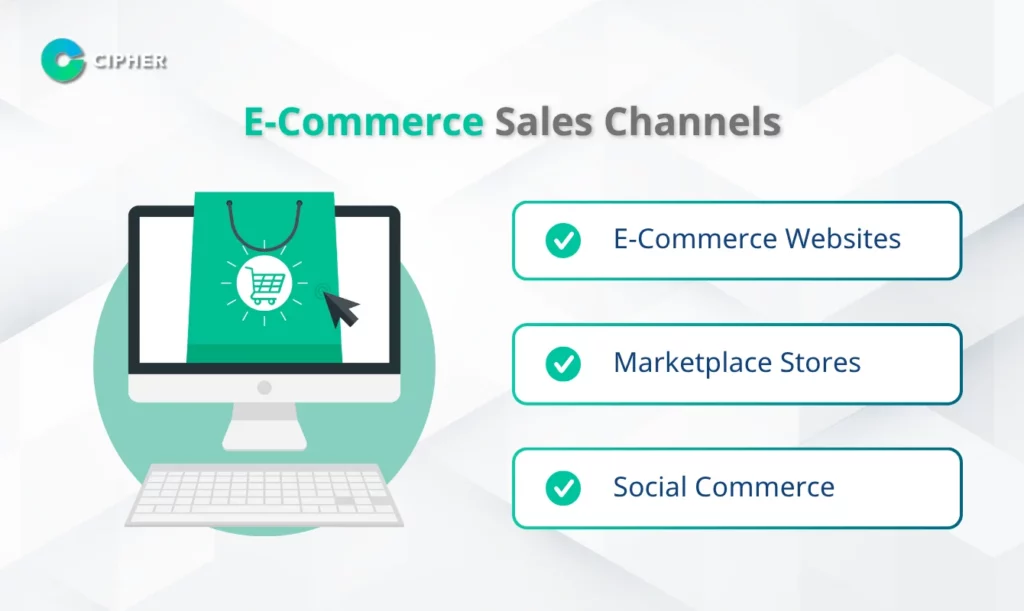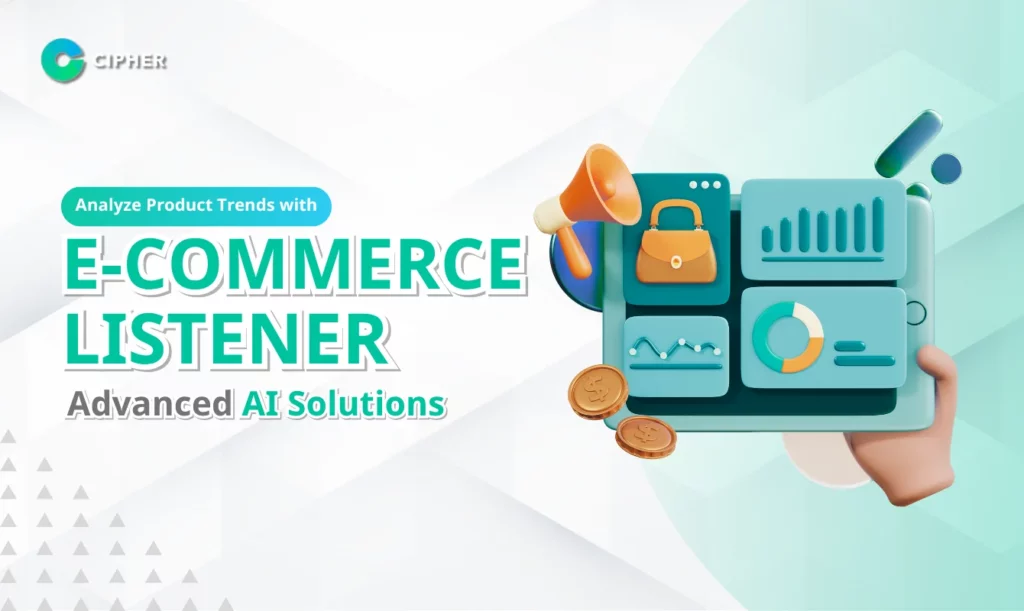Table of Contents
In an era of rapid technological advancement, consumer buying behaviors have changed dramatically. Traditional commerce has been replaced by online trading, commonly known as “E-commerce,” which has gained increasing popularity, especially during the COVID-19 pandemic. This article will introduce you to advanced E-Commerce Listener Tools powered by AI for analyzing product trends and competitors, which will help your business grow exponentially.
What is E-Commerce and Why Is It Important?

E-Commerce, or electronic commerce, refers to buying and selling goods or services over the internet without direct contact between buyers and sellers, commonly known as “online selling.” It’s an essential component of the Digital Marketing Mix.
E-commerce has grown dramatically from before the pandemic to the present day. The main reasons include convenience and speed of ordering, ability to access global markets, and lower costs compared to opening traditional retail stores. According to Statista, online trading volume in 2023 increased to $6.3 trillion from just $3.5 trillion in 2019 and is expected to reach $8.1 trillion by 2026.
The Importance of Analyzing Product Trends and Competitors in E-Commerce
Currently, competition in the E-commerce business is intensifying. Entrepreneurs need tools to analyze market trends and competitors to adapt and increase competitiveness promptly. E-Commerce Listener Tools are designed to meet this need.
E-Commerce Listener Tools, also called Social Listening Tools for E-commerce, are intelligent marketing tools that help online marketers plan effective sales strategies across platforms like Shopee and Lazada. As Revuze explains, these tools use AI analysis and processing to help users access insights that can be developed further, generate new ideas, and create content that precisely reaches target customers.
Key Components of E-Commerce Listener Tools
1. Market Analysis
Market Analysis helps analyze Digital Shelf on Shopee and Lazada, discovering product groups with growth potential from keywords or categories, and provides insights about sales performance, trending products, and competitor information in one place.
Key features of Market Analysis include:
- Search through filters: Search by product name, keyword, category, brand, store, product price, sales channel, or specifically Shopee Mall and LazMall
- Market overview: Displays total products and stores, sales value, number of units sold, average price, and number of reviews
- Market share: View in two dimensions—both sales and units sold—for the Top 10 best-selling stores or top brands with the largest market share
- Sales trends: Shows estimated sales trend graphs for each selected week to analyze sales trends
- Pricing trends: Displays average selling price trend graphs during the selected weeks and proportion of price ranges according to the number of products in the system
- Top 100 best-selling products: Shows information about best-selling products with images, product names, store names, star ratings, selling prices, units sold, and estimated sales
2. Product Explorer
Product Explorer helps answer important questions about selling products on Shopee and Lazada, such as what products to sell, which products are trending, what competitors are selling and at what price, and what the sales trends look like.
Key features of Product Explorer include:
- Product information: Displays product images during selected weeks, product names, brand names, categories, selling prices, sales, and approximate units sold
- Store information: Shows basic store information, sales channels, Mall status, number of followers, store ratings, with links to more store details
- Growth trends: Displays trend graphs of changes in selling prices, sales, and approximate units sold during selected weeks
3. Store Explorer
Store Explorer helps track competitor or partner stores on Shopee/Lazada in one place, including sales data, pricing, and best-selling products, divided into stores, brands, and categories.
Key features of Store Explorer include:
- Store information: Shows store names and images, Mall status, sales channels, number of followers, store ratings, chat response rates, and links to actual stores on Shopee and Lazada
- Sales performance: Shows store performance from product data during selected weeks, including average selling price, units sold, estimated sales, and number of products in the system, along with trend graphs
- Top-selling products: Displays information about best-selling products in that store, with growth trends according to selected weeks, sortable by selling price, units sold, and estimated sales from high to low or low to high
The Role of Social Listening Tools in E-Commerce
Social Listening Tools are important components of E-Commerce Listener Tools for digital marketers, helping businesses better understand consumer behavior, know what customers want and talk about, and apply this information effectively to online marketing.
The main functions of Social Listening Tools include:
- Measuring brand quality: Evaluating public perception of brands or products
- Analyzing industry insights: Analyzing conversations or hashtags within the industry
- Competitor analysis: Studying competitors’ brands or products
- Campaign analysis: Reporting on marketing campaign responses
- Situation monitoring: Tracking consumer responses to various events
Benefits of E-Commerce and Using E-Commerce Listener Tools
Advantages of E-Commerce:
- Continuously growing market: E-Commerce has been growing steadily and is expected to continue expanding in the future
- Global market access: Can reach customers worldwide with just a few clicks, allowing consumers to easily choose and compare products
- Lower costs: No need for physical stores, saving on space, equipment, and staff costs; stores can be open 24 hours without supervision
- Direct customer contact: Communicate directly with customers without intermediaries, helping to better understand customer needs and satisfaction
Considerations for E-Commerce
While E-Commerce has many benefits, not all businesses may be suitable for this channel. Before starting, consider these limitations:
- Negotiation limitations: Customers cannot touch or try products before buying, which may cause hesitation about quality, especially for clothing or shoes. Building a trustworthy brand is therefore important.
- Technical issues: Online trading relies on the internet and electronic devices. If signal problems occur, websites crash, or devices are damaged, it can affect user experience and sales.
- Data security: In the digital age where data is highly valuable, security is important. Care must be taken to prevent customer data leaks, which could damage reputation and business.
- Shipping problems: As business expands, shipping large quantities of products becomes more difficult. Shipping costs, delivery times, and damage during transit must be considered, which can affect customer satisfaction.
What Types of Products Sell Well in E-Commerce?
In the digital world, almost all types of products can be sold through E-Commerce as long as they are legal and can be delivered through shipping systems. Products sold through E-Commerce are divided into three main categories:
- Physical Goods: Such as furniture, appliances, clothing, or consumer products
- Digital Goods: Such as applications, software, music, movies, images, game codes, or in-game items
- Convenience Services: Such as airline/movie ticket bookings, hotel accommodations, beauty clinics, etc.
For products to sell well, it’s important to differentiate from competitors, make products interesting, and meet consumer needs. After that, marketing helps make products known and reach target audiences.
E-Commerce Sales Channels

1. E-Commerce website
E-Commerce websites are sites with online buying and selling functions for goods and services. Sellers can create their own or use E-Commerce Website Development services from experts.
Advantages:
- Creates identity and credibility for the brand
- Design websites according to business needs
- Collect and analyze customer data independently
Considerations:
- High initial costs for design, website development, and marketing
- Must maintain and update the website regularly
2. Marketplace store
Marketplaces are E-Commerce websites that gather products and services from multiple sellers, providing services through websites or applications, with systems for creating stores, shipping, returns, and online payments, such as Lazada or Shopee.
Advantages:
- Immediately reach many customers with little marketing investment
- Complete buying and selling system, convenient for both buyers and sellers
- Can start immediately without a physical store or creating your own website, saving costs
Considerations:
- Annual fees or sales commissions to be paid to the Marketplace
- High competition, must focus on pricing and promotions
- Must learn to use tools and techniques for each platform
3. Social Commerce
Social Commerce is buying and selling products through social media, used as a channel to promote and communicate with customers. Orders can be placed directly through social media or through connected apps, such as Facebook Marketplace or Line Shopping, which is part of Social Media Marketing.
Advantages:
- Buyers and sellers can communicate directly, negotiate prices
- Build brand and trust with customers through content strategies
- Many users and continuously increasing, can precisely target advertising to specific groups
Considerations:
- Less reliable than other channels because E-commerce support systems are not yet complete
- Not all products are suitable for all platforms; must study target audiences in detail
E-Commerce Trends for 2025
E-Commerce continues to be a business trend with high potential for the future, with notable directions including:
- Continued growth: E-Commerce will remain important in meeting consumer needs, especially after the COVID-19 situation where people have become more familiar with online shopping
- Intensified competition: In quality, price, and service, sellers must continuously adapt and develop to meet customer needs
- Increased use of technology: Various technologies such as AI and VR/AR will play roles in data analysis, product recommendations, and creating more interesting buying experiences
- Building customer relationships: Sellers will focus on building good relationships with customers through information, advice, discounts, and special privileges to maintain customer base
Cipher's Services
Cipher is a comprehensive Digital Marketing agency specializing in analyzing and developing online marketing strategies, especially for E-commerce businesses. We offer services covering all aspects of digital marketing:
1. E-Commerce Listener Tools & Analytics
2. SEO & Content Marketing
We develop high-quality content that follows SEO principles, helping your website rank at the top of search results with a team of content and SEO experts who understand Google ranking techniques.
3. Social Media Marketing
4. E-Commerce Platform Development
5. Market Research & Strategic Planning
Summary
E-Commerce Listener Tools are advanced AI tools that help analyze product trends and competitors in the rapidly growing E-Commerce market. They help businesses understand consumer behavior, discover new business opportunities, and develop effective marketing strategies. Cipher is ready to be your partner in helping your business succeed with comprehensive Digital Marketing services and E-Commerce Listener Tools strategies with advanced analytical tools. Contact us today to elevate your business to success in the digital world.
Frequently Asked Questions
How do E-Commerce Listener Tools differ from regular Social Listening Tools?
How should small businesses start using E-Commerce Listener Tools?
Small businesses should start by clearly defining what information they need, such as competitor analysis, finding products with growth potential, or appropriate pricing. Then choose services with affordable starter packages. You can consult with experts from Cipher to find a package suitable for your business size and needs.





